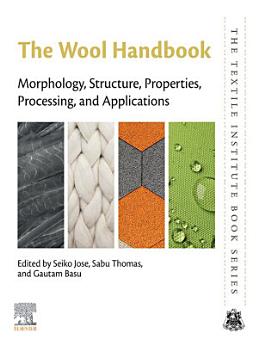The Wool Handbook: Morphology, Structure, Properties, Processing, and Applications
About this ebook
About the author
Seiko Jose PhD is a scientist, working at ICAR-Central Sheep and Wool Research Institute, Avikanagar, Rajasthan, India. He has over 17 years’ experience in textiles including time spent in industry and academia. His industrial experience is focused on wet processing of cotton, silk, and linen processing units. For the last 8 eight years of his research career, he has worked with a range of natural fibres such as, wool, jute, pineapple leaf fibre, coir, flax, and ramie. He has contributed to 30 research papers and 9 book chapters. His major research areas are extraction and characterization of natural fibre, textile dyeing and finishing, eco-friendly textile processing, natural fibre composites, and natural dyes.
Sabu Thomas is a Professor and Director of the International and Interuniversity Centre for Nanoscience and Nanotechnology, Mahatma Gandhi University, Kerala, India. Professor Thomas is internationally recognized for his contributions to polymer science and engineering, with his research interests encompassing polymer nanocomposites, elastomers, polymer blends, interpenetrating polymer networks, polymer membranes, green composites, nanocomposites, nanomedicine, and green nanotechnology. His groundbreaking inventions in polymer nanocomposites, polymer blends, green bionanotechnology, and nano-biomedical sciences have significantly advanced the development of new materials for the automotive, space, housing, and biomedical fields.
Dr Gautam Basu is the former Principal Scientist & Head of the Mechanical Processing Division, ICAR-National Institute of Natural Fibre Engineering and Technology, Kolkata, West Bengal, India. He completed his Masters degree in Textile Technology and his Ph. D. in Polymer Science & Technology from the University of Calcutta. He is a fellow of Institution of Engineers (India). He has published nearly 100 papers, including research, review, training manual, lecture notes, seminar proceedings, in addition to six books and thirteen book chapters. Four patents have been awarded to him and two others are under process. His 40 years of work experience includes 9 years in Industry and 31 years in research institutes. His major areas of work are, investigation of structure and property of natural fibres and their value addition, improvement in process performance of natural fibres through various pre-treatments, technical textiles including geotextiles, and development of machinery & testing instruments. He was a member of various recommending bodies (on natural fibres) formed by Government agencies. He was involved in 28 research projects including as Principal Investigator of the World Bank, and Govt. of India funded projects. He is having more than 950 Google citations with H index of 16.






